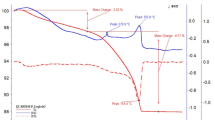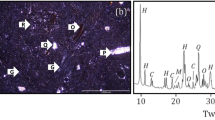Abstract
In this study, the engineering behaviors of rocks exposed to temperatures ranging from 200 to 1000 °C were investigated and changes in the geomechanical properties, as well as related mineralogical changes, were examined. To reduce the effect of rapid heating and prevent the formation of new thermo-mechanical cracks, a heating rate of 10 °C/min was used. In addition, a heating time of 2 h was applied for each temperature degree to observe the thermal heating effect. After heating, the samples were left to cool to room temperature, both dry or immersed in water. The strength of the samples gradually decreased from 128 to 25 MPa with increasing temperature. The strength value decreases by about 70% for the samples cooled in air and by about 80% when cooled in water. The strength decrease was greater for the water-cooled samples because of new microcracks and glass material formed during sudden cooling. The effect of different temperature degrees on rock samples was evaluated separately and approximately 80% of total strength decrease occurred in the 600–700 °C range. Also, new mineral formation and melting of the existent minerals were not observed, although the structural properties were significantly changed at these temperatures. At 800 °C and above, some secondary minerals (e.g., melilite and augite) were formed. Partial melting was seen at temperatures higher than 1000 °C. In the study, a predictive model as a function of the strength for determination of thermal damage on rocks was also suggested. Some equations characterized by a correlation coefficient of 96% were suggested, based on the curves of thermal damage, to predict the uniaxial compressive strength for the designed temperature.









Similar content being viewed by others
References
Allison RJ, Bristow GE (1999) The effects of fire on rock weathering: some further considerations of laboratory experimental simulation. Earth Surf Process Landf 24(8):707–713
ASTM (2008) D2845–08 standard test method for laboratory determination of pulse velocities and ultrasonic elastic constants of rock. ASTM International, West Conshohocken
Aydın F, Karsli O, Chen B (2008) Petrogenesis of the Neogene alkaline volcanics with implications for post-collisional lithospheric thinning of the eastern Pontides, NE Turkey. Lithos 104 (1–4):249–266
Becattini V, Motmans T, Zappone A, Madonna C, Haselbacher A, Steinfeld A (2017) Experimental investigation of the thermal and mechanical stability of rocks for high-temperature thermal-energy storage. Appl Energy 203:373–389
Bergman MS (1980) Nuclear waste disposal. Subsurf Space 2:791–1005
Bieniawski ZT (1974) Estimating the strength of rock materials. J South Afr Instit Min Metall 74:312–320
Brown ET (1981) Rock characterization, testing and monitoring (ISRM suggested methods). Pergamon, Oxford, pp 171–183
Chaki S, Takarli M, Agbodjan (2008) Influence of thermal damage on physical properties of a granite rock: porosity, permeability and ultrasonic wave evolutions. Constr Build Mater 22:1456–1461
Chen YL, Ni J, Shao W, Azzam R (2012) Experimental study on the influence of temperature on the mechanical properties of granite under uni-axial compression and fatigue loading. Int J Rock Mech Min Sci 56:62–66
Darot M, Reuschle T (2000) Acoustic wave velocity and permeability evolution during pressure cycles on a thermally cracked granite. Int J Rock Mech Min Sci 37:1019–1026
David C, Menendez B, Darot M (1999) Influence of stress-induced and thermal cracking on physical properties and microstructure of la Peyratte granite. Int J Rock Mech Min Sci 36:433–448
Deer WA, Howie RA, Zussman J (1992) An introduction to the rock-forming minerals. 2nd ed. Longman, Hong Kong
Demuth RB, Harlow FH (1980) Geothermal energy enhancement by thermal fracture. Los Alamos National Laboratory Report LA-8428. Los Alamos National Laboratory Report, Los Alamos
Dwivedi RD, Goel RK, Prasad VVR, Sinha A (2008) Thermo-mechanical properties of Indian and other granites. Int J Rock Mech Min Sci 45:303–315
Ersoy H, Fırat Ersoy A, Bulut F, Berkün M (2008) Municipal solid waste management and practices in coastal cities of eastern Black Sea; a case study of Trabzon City (NE Turkey). Bull Eng Geol Environ 67:321–333
Ersoy H, Yalçınalp B, Babacan AE (2014) Investigation of geological and Geomechanical properties of the Saraftepe (Trabzon) Tephritic sill. Jeol Mühendisliği Derg 38(1):39–50 (in Turkish with English abstract)
Ferrero AM, Marini P (2001) Experimental studies on the mechanical behaviour of two thermal cracked marbles. Rock Mech Rock Eng 34:57–66
Glover PWJ, Baud P et al (1995) α-β phase transition in quartz monitored using acoustic emissions. Geophys J Int 120:775–782
Harputlu H (2016) The investigation of changes in the physical and mechanical properties of saraftepe tephrites (Trabzon,Turkey) with temperature. KTU Institute of Science and Technology 65 pp (in Turkish with English abstract)
Heueckel T, Peano A, Pellegrint R (1994) A constitutive law for thermo plastic behavior of rocks: an analogy with clays. Surv Geophys 15:643–671
Heuze FE (1983) High-temperature mechanical, physical and thermal properties of granitic rocks-a review. Int J Rock Mech Min Sci and Geomech Abstr 20(1):3–10
Iliev IG (1967) An attempt to estimate the degree of weathering of intrusive rocks from their physico-mechanical properties. Proc First Congr Int Soc Rock Mech 1:109–114
ISRM (2007) The complete ISRM suggested methods for rock characterization, testing and monitoring: 1974–2006. Suggested methods prepared by the commission on testing methods, International Society for Rock Mechanics. In: Ulusay R, Hudson JA (eds) Compilation arranged by the ISRM Turkish National Group. Kozan Ofset, Ankara
Jones C, Keaney G, Meredith PG, Murrell SAF (1997) Acoustic emission and fluid permeability measurements on thermally cracked rocks. Phys Chem Earth 22:13–17
Khare S, Dell’Amico M, Knight C, McGarry S (2013) Selection of materials for high temperature sensible energy storage. Solar Energy Mater Sol Cells 115:114–122
Knapp RB, Norton D (1981) Preliminary numerical analysis of processes related to magma crystallization and stress evolution in cooling pluton environments. Am J Sci 281:35–68
Koca MY, Özden G, Yavuz AB, Kıncal C, Onargan T, Küçük K (2006) Changes in the engineering properties of marble in fire-exposed columns. Int J Rock Mech Min Sci 43:520–530
Koide H, Bhattacharji S (1975) Formation of fractures around magmatic intrusions and their role in ore localization. Econ Geol 70:781–799
Lau JSO, Gorski B, Jackson R (1995) The effects of temperature and water saturation on mechanical properties of lacdu bonnet pink granite. 8th International Congress on Rock Mech. Tokyo 1167–1172
Lion M, Skoczylas F, Ledesert B (2005) Effects of heating on the hydraulic and poroelastic properties of bourgogne limestone. Int J Rock Mech Min Sci 42:508–520
Liu QS, Xu XC (2000) Damage analysis of brittle rock at high temperature. Chin J Rock Mech Eng 19(4):408–411
Logan SE (1973) Deep self-burial of radioactive wastes by rock melting capsules. Trans Am Nucl Soc Ann Mtg:177–178
Mao XB, Zhang LY, Zhen TZ, Liu HS (2009) Properties of failure mode and thermal damage for limestone at high temperature. Min Sci Technol 19:0290–0294
Mercer JW Jr (1973) Finite element approach to the modelling of hydrothermal systems [dissertation]. University of Illinois, Champaign
Singh B, Goel RK (2011) Engineering rock mass classification, Tunnelling, foundations, and landslides. Elsevier, Amsterdam
Sun Q, Lü C, Cao L, Li W, Geng J, Zhang W (2016) Thermal properties of sandstone after treatment at high temperature. Int J Rock Mech Min Sci 85:60–66
Tang F, Mao X, Zhang L, Yin H, Li Y (2011) Effects of strain rates on mechanical properties of limestone under high temperature. Min Sci Technol 21(6):857–861
Tüysüz N, Yaylalı Abanuz G (2012) Jeoistatistik Kavramlar ve Bilgisayarlı Uygulamalar. KTÜ Matbaası Yayın No: 220 Trabzon (in Turkish)
Wang JT, Zhao A, Huang MC (1989) Effect of high temperature on the fracture toughness of granite. Chin J Geotech Eng 11(6):113–119
Wu Z, Qin BD, Chen LJ, Luo YJ (2005) Experimental study on mechanical character of sandstone of the upper plank of coal bed under high temperature. Chin J Rock Mech Eng 24(11):1863–1867
Xia XH, Wang YY, Huang XC (2004) Experimental study on high temperature effects on the strength and deformation quality of marble. J Shanghai Jiaotong Univ 38(6):996–1002
Xu XC (2003) Study on the characteristics of thermal damage for granite. Rock Soil Mech 24(Suppl. 2):188–191
Yavuz H, Altindag R, Sarac S, Ugur I, Sengun N (2006) Estimating the index properties of deteriorated carbonate rocks due to freeze–thaw and thermal shock weathering. Int J Rock Mech Min Sci 43:767–775
Yavuz H, Demirdag S, Caran S (2010) Thermal effect on the physical properties of carbonate rocks. Int J Rock Mech Min Sci 47(1):94–103
Yücel C, Arslan M, Temizel İ, Abdioglu Yazar E (2014) Volcanic facies and mineral chemistry of Tertiary volcanics in the northern part of the Eastern Pontides northeast Turkey implications for pre eruptive crystallization conditions and magma chamber processes. Mineral Petrol 108(3):439–467
Zhang JY, Ma WC, Zhang FP (1996) On rock structure character under high temperature. Chin J Geotech Eng 17(1):5–9
Zhang LY, Mao XB, Lu AH (2009) Experimental study on the mechanical properties of rocks at high temperature. Sci China Ser E Technol Sci 52(3):641–646
Acknowledgements
This research was partly funded by the Karadeniz Technical University Scientific Research Projects Unit (Project ID: 6326-1226 and 6211-716). The authors would like to thank the reviewers for their constructive contributions.
Author information
Authors and Affiliations
Corresponding author
Rights and permissions
About this article
Cite this article
Ersoy, H., Kolaylı, H., Karahan, M. et al. Effect of thermal damage on mineralogical and strength properties of basic volcanic rocks exposed to high temperatures. Bull Eng Geol Environ 78, 1515–1525 (2019). https://doi.org/10.1007/s10064-017-1208-z
Received:
Accepted:
Published:
Issue Date:
DOI: https://doi.org/10.1007/s10064-017-1208-z




